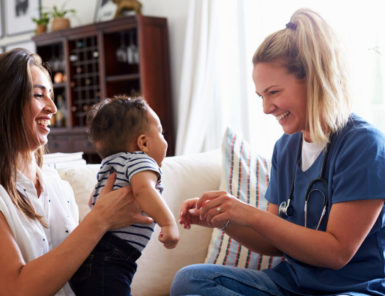
Harnessing Opportunities for Positive Early Childhood (HOPE)
HOPE (Harnessing Opportunities for Positive Early Childhood) helps state leaders work together, across sectors and with families and local providers, to transform places marginalized by inequality into areas of high opportunity.
No single state or local agency on its own can increase benefits in education, health, economic stability and neighborhood environments for children and families living in disinvested communities.
Funded by the Robert Wood Johnson Foundation, HOPE use strategies to help state leaders build and strengthen cross-sector teams that work across child and family-serving systems, including child care, health and mental health, housing, workforce development, nutrition, parks and recreation, transportation, and others.
HOPE offers state leaders strategies and tools that can increase access to and benefits from services and supports in marginalized communities. Shifts in policy and practice are guided by the voices of the intended beneficiaries and community leaders. These voices become a part of the system design, implementation, and monitoring process through ongoing feedback loops that are established and sustained by state leaders and communities.
HOPE Goals
Each and every child, regardless of race, neighborhood, or family income, should have equitable opportunities to achieve positive health and education outcomes. To achieve that vision, HOPE works with state and local leaders to:
- Promote optimal health and well-being for families prenatally and children up to age five, prevent and mitigate early childhood adversities, and improve adverse social settings.
- Shift or realign systems, focusing on policies, practices, programs, initiatives, funding, governance, data, and communication that increase opportunity for young children and families in communities with significant racial, ethnic, economic, health, and education disparities.
- Engage community members with lived experience and create feedback loops to ensure consistent communication between state and local policy makers, practitioners, community leaders, and families.
HOPE brings state leaders together in a phased, intentional process to change how they work across systems and in communities to benefit young children and families.
 In this process, HOPE helps state leaders find the time, space, and place to:
In this process, HOPE helps state leaders find the time, space, and place to:
- Build and refine cross-sector/system efforts that are community driven.
- Identify priorities to reduce inequities by analyzing data and implementing continuous feedback loops between community and state processes and among multiple state leaders.
- Use quantitative and qualitative data to drive decision-making and for surveillance and continuous improvement.
- Redistribute state and community resources to reduce inequities by leveraging state resources and policies to increase opportunity in specific communities.
HOPE is activating state and community leaders to learn:
- Programs they thought were working well are not having their desired impact within marginalized communities.
- A shared analysis of national, state, and local data, along with intentional efforts to listen to and learn from community leaders and program beneficiaries is needed to learn the impact of services and supports on children’s lives.
- Shifts are necessary to improve access to and benefit from quality child care, health and mental health services, and job training and placement.
State and community leaders work better together. No single state or local agency can, on its own, achieve better, more equitable outcomes for children and families living in low-opportunity communities.
Emerging Lessons
HOPE evaluation and documentation efforts highlight the following key points based on interviews, meetings, and surveys with state leaders:
Strengthening teams of cross-sector state leaders
HOPE has provided opportunities at the state and local level to see system issues and possible solutions as a whole, not piecemeal, and in context, not as monolithic. HOPE also has provided opportunities to see and address funding gaps as well as overlaps in services and resources.
Using data differently
Combining quantitative and qualitative data has provided state leaders with an opportunity to understand the hopes and dream of families and look anew at access to and effectiveness of programs, services, and initiatives. State leaders have begun to understand challenges and root causes preventing child and family well-being. Data disaggregated by race and place also has helped highlight where state and local leaders can tailor strategies to increase opportunities for specific populations.
Listening to beneficiaries and creating feedback loops
Planning and organizing beneficiary voice visits and beginning work to establish state-community connections has given state leaders opportunities to: “go deep” in places and have the responsibility to respond accordingly; understand local conditions; and see intersections across sectors, such as early care and education, economic development, health, workforce development, and other programs and to increase the effectiveness of services, supports, and initiatives.
Increasing access to opportunity
State leaders can take new action or examine previous efforts they thought were working within the scope of their own roles, responsibilities, influence, and authority. Using quantitative data and the voices of communities, they can tailor programs, services, and support to assure they benefit young children and their families.
Explore HOPE Resources

Project HOPE Evaluation and Documentation Findings
Research May 22, 2020
The overarching goal of Project HOPE is to transform low-opportunity communities into high-opportunity communities and to achieve this by promoting the optimal health and well-being of young children, families and communities. This evaluation report documents the progress made between November 2019 and April 2020 in promoting health and racial equity in four states – Alabama, California, Minnesota, and New Jersey.
Learning and Acting in Real Time: How the BUILD Initiative is Responding to Families’ Needs During the Pandemic
Blog April 28, 2020
Read this blog for information on COVID-19 support the BUILD Initiative has provided to each of the eight Project HOPE focus communities through small grants. Project HOPE supports state, tribal, and community leaders to increase access to state programs, services, and initiatives to improve health equity for children and families.
Overview of HOPE State Efforts
Article July 22, 2021
HOPE, a BUILD Initiative project, works to ensure that each child, regardless of race, neighborhood, or family income, has equitable opportunities to achieve positive health and education outcomes. This overview looks at HOPE efforts underway in Alabama, California, Minnesota, and New Jersey.
Explore HOPE Collections
HOPE Team
Sherri Killins Stewart Ed.D.
Director of Systems Alignment and Integration, Co-Director of State Services
Carey McCann
Co-Director of State Services
Michelle Stover Wright
Research and Evaluation Manager

